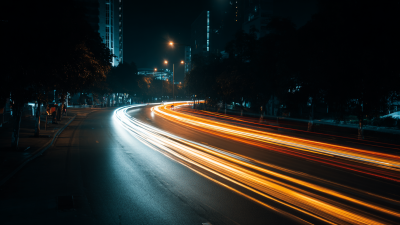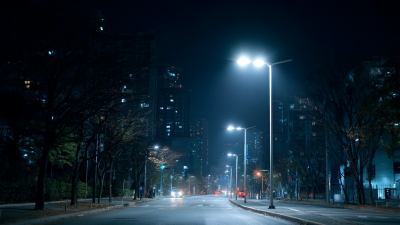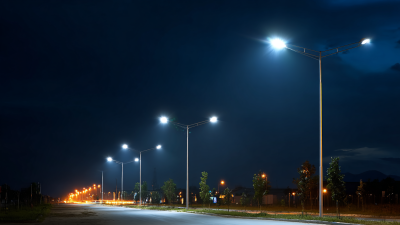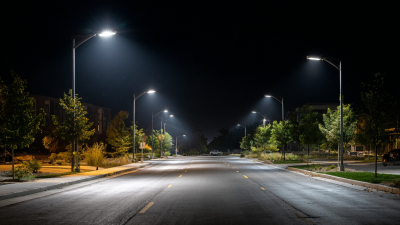
Top 10 Solar Lights in 2025 for Efficient Outdoor Illumination
As we move towards a more sustainable future, solar lights have emerged as a vital solution for efficient outdoor illumination. With advancements in technology and design, these eco-friendly lighting options are becoming increasingly popular for their energy-saving capabilities and ease of installation. In 2025, selecting the right solar lights has never been more critical for homeowners and outdoor enthusiasts alike, as these fixtures not only enhance the aesthetic appeal of outdoor spaces but also contribute to lower electricity bills and reduced carbon footprints.
In this article, we will explore the top 10 solar lights that stand out for their performance, durability, and innovative features. Whether you need lighting for your garden, patio, or pathway, solar lights offer a versatile range of applications. Furthermore, with various styles and brightness levels available, finding the perfect fit for your outdoor environment is easier than ever. Join us as we delve into the best solar light options of 2025, illuminating the path toward a greener and brighter outdoor experience.
Read more »
 By:Lila - December 11, 2025
By:Lila - December 11, 2025

2025 Top 10 Solar Street Lights: Ultimate Guide to Sustainable Illumination
As urban centers strive to enhance their sustainability initiatives, solar street lights have emerged as a crucial element in the transition towards greener cities. According to a report by the International Energy Agency (IEA), the adoption of solar street lights can reduce energy consumption by up to 80%, making them a highly efficient lighting alternative for public spaces. As we navigate towards 2025, the integration of innovative technology in solar street lights is expected to propel the market growth, which is forecasted to reach $6.89 billion by 2025, as highlighted in a recent report by Market Research Future.
Experts like Dr. Emily Johnson, a leading scholar in renewable energy solutions, emphasize the transformative potential of solar street lights. She states, “By harnessing solar energy, we can not only illuminate our streets but also pave the way for a sustainable future.” This powerful assertion highlights the dual benefits of adopting solar street lights—not only do they enhance visibility and safety for pedestrians, but they also contribute to reducing carbon footprints and promoting environmentally friendly practices in urban infrastructure. As we present the "2025 Top 10 Solar Street Lights" guide, it becomes essential to explore these advancements that promise to illuminate the path toward sustainability.
Read more »
 By:Sophia - December 2, 2025
By:Sophia - December 2, 2025

10 Essential Tips for Choosing the Best Solar Street Lights for Your Community
As communities worldwide strive for sustainability and energy efficiency, the adoption of solar street lights has become increasingly prevalent. According to Dr. Emily Thompson, a leading expert in renewable energy solutions, "Solar street lights not only illuminate our streets with clean energy but also represent a significant step towards reducing our carbon footprint." This statement emphasizes the importance of choosing the right solar street lights tailored to the unique needs of each neighborhood.
In 2025, the quest for optimal solar street lighting solutions will be more critical than ever. With advancements in technology and a growing emphasis on sustainable urban development, communities must carefully evaluate various factors when selecting solar street lights. These factors include brightness, battery life, installation ease, and adaptability to local weather conditions. The right choices can enhance safety, visibility, and aesthetic appeal while ensuring an environmentally friendly approach to public lighting.
This guide aims to provide essential tips for selecting the best solar street lights, empowering communities to make informed decisions that align with their sustainability goals and improve the quality of life for their residents. By prioritizing thoughtful selection, communities can reap the benefits of solar street lights for years to come.
Read more »
 By:Sophia - November 21, 2025
By:Sophia - November 21, 2025

Illuminate Your Garden: The Ultimate Guide to Choosing the Perfect Solar Lamp
When it comes to enhancing the beauty and functionality of your outdoor spaces, choosing the right solar lamp can make all the difference. Solar lamps not only illuminate your garden but also contribute to an eco-friendly lifestyle by harnessing the power of the sun. With advancements in solar technology, there is an impressive variety of designs, styles, and features available to suit every garden aesthetic. Whether you are looking to create a romantic ambiance, boost security, or highlight your favorite plants, understanding the different types of solar lamps is essential. This ultimate guide will help you navigate the myriad of options and considerations, ensuring you select the perfect solar lamp that aligns with your needs and elevates your garden's appeal. From brightness levels to design elements and placement strategies, get ready to illuminate your garden in a way that is both beautiful and sustainable.
Read more »
 By:Isabella - November 12, 2025
By:Isabella - November 12, 2025

How Smart Street Lights Are Revolutionizing Urban Safety and Energy Efficiency
As urban populations continue to swell, cities face the dual challenge of enhancing safety and improving energy efficiency. According to a recent report by the International Energy Agency, street lighting accounts for nearly 19% of global electricity consumption in urban areas, underscoring the urgent need for modernization. Smart street lights, equipped with sensors and connected to IoT (Internet of Things) networks, are emerging as a transformative solution. By integrating adaptive lighting technology, cities can reduce energy usage by up to 50% while simultaneously increasing public safety through improved visibility and real-time monitoring. Furthermore, a study published by the Urban Institute indicates that well-lit streets significantly reduce crime rates, illustrating the impact of smart street lighting on community safety. As cities strive for sustainability and security, the evolution of street light technology stands at the forefront of urban innovation, promising to reshape our urban landscapes for the better.
Read more »
 By:Sophia - November 7, 2025
By:Sophia - November 7, 2025

How Solar Lamps Are Revolutionizing Outdoor Spaces and Saving Energy in 2023
In 2023, the emergence of solar lamps has marked a transformative shift in outdoor lighting, blending sustainability with functionality. According to a recent report by Global Market Insights, the solar lighting market is projected to reach $14 billion by 2030, driven by a growing demand for energy-efficient alternatives. Solar lamps not only provide illumination but also significantly reduce electricity costs, with studies showing that they can save up to 80% in energy consumption compared to traditional lighting solutions. As urban areas increasingly prioritize eco-friendly initiatives, the adoption of solar lamps in parks, gardens, and outdoor recreational spaces has surged, offering customizable designs that enhance aesthetics while supporting environmental sustainability. This revolutionary approach not only promotes energy conservation but also empowers communities to invest in greener solutions, highlighting the integral role solar lamps play in the future of outdoor spaces.
Read more »
 By:Isabella - November 4, 2025
By:Isabella - November 4, 2025

Transform Your Neighborhood with Innovative Solar Street Lights: A Sustainable Solution for Safer Streets
In the quest for safer and more sustainable communities, the implementation of solar street lights stands out as an innovative solution that can transform neighborhoods. These eco-friendly lighting systems not only provide enhanced visibility during nighttime but also reduce energy costs and minimize carbon footprints. By harnessing the power of the sun, solar street lights automatically recharge during the day, ensuring they remain operational throughout the night without relying on conventional electrical grids. This introduction of renewable energy into our urban infrastructure represents a significant step towards creating greener, safer streets where pedestrians and cyclists feel more secure. As communities continue to prioritize sustainability, understanding how to effectively integrate solar street lights into local environments becomes essential. This article will guide you through the process of transforming your neighborhood with these cutting-edge technologies, highlighting their benefits and providing practical steps for implementation.
Read more »
 By:Isabella - October 25, 2025
By:Isabella - October 25, 2025

Innovative Trends in LED Street Lights Unveiled at 2025 China Import and Export Fair
The lighting industry is witnessing a transformative shift, particularly in the realm of LED street lights, which are becoming a focal point at the 2025 China Import and Export Fair. As reported by the International Energy Agency (IEA), the global LED street lighting market is anticipated to reach USD 21 billion by 2025, driven by the need for energy-efficient solutions in urban areas. Innovative trends unveiled at this fair highlight advancements in smart technology integration, energy management, and sustainable design, responding to the growing demand for eco-friendly urban infrastructure. The World Bank projects that upgrading to LED street lights can result in energy savings of up to 50-80%, making them a pivotal component in urban planning and environmental sustainability efforts. As cities worldwide pivot towards smarter, greener solutions, the innovations presented at this prestigious event underscore the vital role of LED street lights in shaping the future of urban environments.
Read more »
 By:Isabella - October 21, 2025
By:Isabella - October 21, 2025

Shining Bright: Solar Street Lights at the 138th Canton Fair 2025 - Transforming Urban Lighting Solutions
As urban areas continue to grow and evolve, the demand for sustainable and efficient lighting solutions has never been more critical. Solar street lights have emerged as a pivotal technology in this context, offering a renewable energy alternative that significantly reduces electricity costs and carbon footprints. According to a report by Grand View Research, the global solar street lighting market is projected to reach $10.22 billion by 2025, driven by the increasing adoption of smart city initiatives and environmentally friendly urban development. The 138th Canton Fair in 2025 will showcase cutting-edge innovations, highlighting how solar street lights can transform urban lighting solutions in cities around the world. With their ability to provide reliable illumination while harnessing the power of the sun, these systems not only enhance public safety but also contribute to the overall sustainability goals of urban planning.
Read more »
 By:Sophia - October 16, 2025
By:Sophia - October 16, 2025

How to Choose the Right Street Light for Your Urban Environment
In urban environments, the selection of appropriate street lights is crucial for enhancing safety, aesthetic appeal, and energy efficiency. According to the U.S. Department of Energy, lighting accounts for approximately 38% of the total energy use in municipal buildings, highlighting the importance of choosing street lights that not only illuminate effectively but also reduce energy consumption. The International Energy Agency reports that well-designed street lighting can lower crime rates by up to 20%, while also increasing pedestrian visibility. As cities continue to expand, the implementation of smart lighting solutions is becoming increasingly relevant, with the global smart street lighting market projected to reach $8.2 billion by 2025, according to MarketsandMarkets. This underscores the need for urban planners and decision-makers to carefully evaluate various factors such as illumination technology, sustainability, and local community needs when choosing the right street light for their environment.
Read more »
 By:Lila - October 13, 2025
By:Lila - October 13, 2025

How to Choose the Right LED Street Lights for Your Urban Environment
As cities continue to expand and evolve, the importance of effective urban lighting has become increasingly evident. The adoption of LED street lights is gaining traction due to their remarkable efficiency and sustainability benefits. According to a report from the U.S. Department of Energy, LED street lighting can reduce energy consumption by up to 50-70% compared to traditional lighting options, significantly lowering municipal costs while enhancing public safety. Additionally, a survey by the International Dark-Sky Association highlights that well-designed LED street lights can minimize light pollution while providing better visibility for pedestrians and drivers alike. Therefore, making an informed choice in selecting LED street lights is crucial for urban planners aiming to create safer and more energy-efficient environments. This guide aims to provide essential insights into the factors to consider when choosing the right LED street lights for your urban setting.
Read more »
 By:Lila - October 10, 2025
By:Lila - October 10, 2025

Ultimate Guide to Choosing the Right Solar Street Lights for Your Community
As urbanization continues to rise, communities are increasingly seeking sustainable solutions to enhance public safety and reduce energy costs. Solar street lights have emerged as a pivotal component in this transition toward greener infrastructure. According to a report by MarketsandMarkets, the global solar street lighting market is projected to reach USD 11.4 billion by 2025, growing at a CAGR of 22.4% from 2020. This significant growth is driven by the dual benefits of energy efficiency and cost savings, as solar street lights operate independently from traditional electrical grids, thereby reducing municipal energy expenditures. Additionally, the implementation of solar street lights can lead to improved nighttime visibility and security, making them an attractive option for many communities. As local governments navigate the choices available, understanding how to select the right solar street lights tailored to their specific needs becomes crucial for maximizing these benefits.
Read more »
 By:Sophia - October 5, 2025
By:Sophia - October 5, 2025

How to Choose the Right Solar Street Lights for Your Urban Development Needs
The increasing focus on sustainable urban development has positioned solar street lights as a transformative solution for cities aiming to enhance public safety while reducing their carbon footprint. According to a recent report by the International Renewable Energy Agency (IRENA), the solar lighting market is projected to grow significantly, with a compound annual growth rate of over 15% through 2025. This shift is driven by the dual benefits of cost savings on energy and maintenance, along with the ability to provide reliable illumination in off-grid locations. As municipalities evaluate their smart city initiatives, selecting the right solar street lights becomes crucial in optimizing performance, aesthetic integration, and energy efficiency. Understanding the key factors that influence the effectiveness and sustainability of these lighting systems is essential for urban planners and developers striving to create safer and more environmentally friendly urban environments.
Read more »
 By:Isabella - September 28, 2025
By:Isabella - September 28, 2025

How to Choose the Best Solar Powered Lights for Your Outdoor Spaces
As outdoor spaces become essential extensions of our homes, enhancing their ambiance and functionality has never been more important. One of the most effective and eco-friendly ways to illuminate these areas is through the use of solar powered lights. These innovative lighting solutions harness the sun's energy, providing a sustainable and cost-effective option for outdoor illumination. However, with the myriad of choices available in the market, selecting the best solar powered lights can be daunting. Factors such as brightness, design, durability, and ease of installation play crucial roles in making the right decision. In this blog, we will guide you through the essential considerations and tips to help you choose the perfect solar powered lights that will not only elevate the aesthetic of your outdoor spaces but also ensure they are practical and efficient.
Read more »
 By:Isabella - September 24, 2025
By:Isabella - September 24, 2025

How to Choose the Best Solar Powered Outdoor Lights for Your Home and Garden
In recent years, the demand for solar powered outdoor lights has surged, driven by the need for sustainable energy solutions and the increasing awareness of environmental conservation. According to a report by the International Energy Agency, the global market for solar lighting is projected to reach $1.1 billion by 2025, showcasing a growth rate of over 20% annually as more homeowners seek economical and eco-friendly lighting options for their gardens and outdoor spaces. These innovative lights not only reduce electricity bills but also enhance the aesthetics and safety of residential properties. As you consider options for illuminating your home and garden, understanding the various alternatives in solar powered outdoor lights can help you make an informed choice that aligns with your functional needs and environmental goals.
Read more »
 By:Lila - September 20, 2025
By:Lila - September 20, 2025
